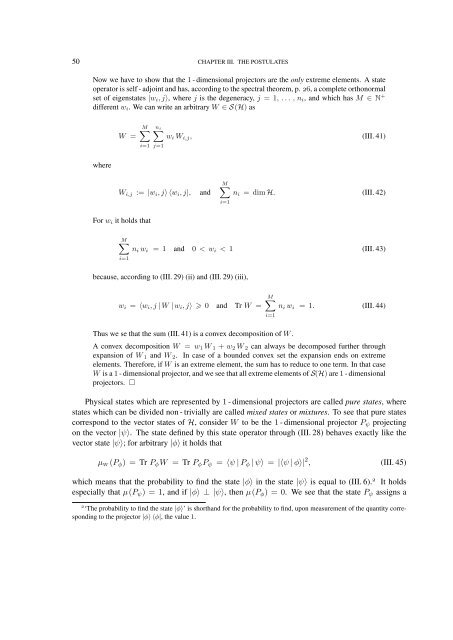FOUNDATIONS OF QUANTUM MECHANICS
FOUNDATIONS OF QUANTUM MECHANICS
FOUNDATIONS OF QUANTUM MECHANICS
You also want an ePaper? Increase the reach of your titles
YUMPU automatically turns print PDFs into web optimized ePapers that Google loves.
50 CHAPTER III. THE POSTULATES<br />
Now we have to show that the 1 - dimensional projectors are the only extreme elements. A state<br />
operator is self - adjoint and has, according to the spectral theorem, p. 26, a complete orthonormal<br />
set of eigenstates |w i , j⟩, where j is the degeneracy, j = 1, . . . , n i , and which has M ∈ N +<br />
different w i . We can write an arbitrary W ∈ S (H) as<br />
W =<br />
M∑<br />
∑n i<br />
i=1 j=1<br />
w i W i,j , (III. 41)<br />
where<br />
W i,j := |w i , j⟩ ⟨w i , j|, and<br />
M∑<br />
n i = dim H. (III. 42)<br />
i=1<br />
For w i it holds that<br />
M∑<br />
n i w i = 1 and 0 < w i < 1 (III. 43)<br />
i=1<br />
because, according to (III. 29) (ii) and (III. 29) (iii),<br />
w i = ⟨w i , j | W | w i , j⟩ 0 and Tr W =<br />
M∑<br />
n i w i = 1. (III. 44)<br />
i=1<br />
Thus we se that the sum (III. 41) is a convex decomposition of W .<br />
A convex decomposition W = w 1 W 1 + w 2 W 2 can always be decomposed further through<br />
expansion of W 1 and W 2 . In case of a bounded convex set the expansion ends on extreme<br />
elements. Therefore, if W is an extreme element, the sum has to reduce to one term. In that case<br />
W is a 1 - dimensional projector, and we see that all extreme elements of S(H) are 1 - dimensional<br />
projectors. □<br />
Physical states which are represented by 1 - dimensional projectors are called pure states, where<br />
states which can be divided non - trivially are called mixed states or mixtures. To see that pure states<br />
correspond to the vector states of H, consider W to be the 1 - dimensional projector P ψ projecting<br />
on the vector |ψ⟩. The state defined by this state operator through (III. 28) behaves exactly like the<br />
vector state |ψ⟩; for arbitrary |ϕ⟩ it holds that<br />
µ W (P ϕ ) = Tr P ϕ W = Tr P ϕ P ψ = ⟨ψ | P ϕ | ψ⟩ = |⟨ψ | ϕ⟩| 2 , (III. 45)<br />
which means that the probability to find the state |ϕ⟩ in the state |ψ⟩ is equal to (III. 6). 2 It holds<br />
especially that µ(P ψ ) = 1, and if |ϕ⟩ ⊥ |ψ⟩, then µ(P ϕ ) = 0. We see that the state P ψ assigns a<br />
2 ‘The probability to find the state |ϕ⟩’ is shorthand for the probability to find, upon measurement of the quantity corresponding<br />
to the projector |ϕ⟩ ⟨ϕ|, the value 1.
















